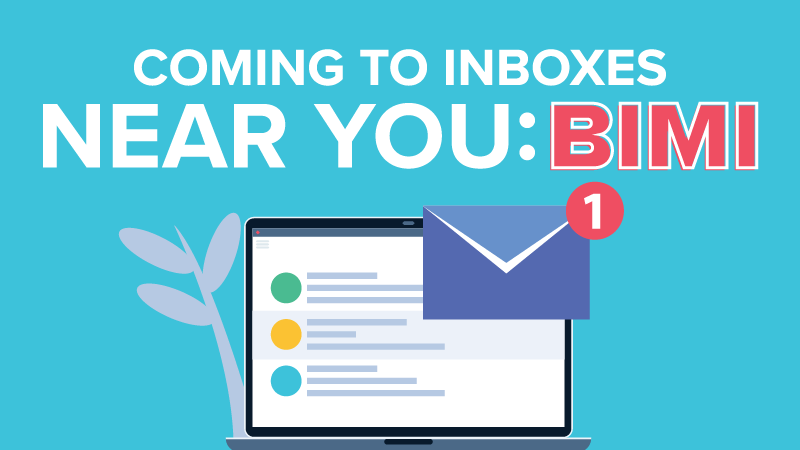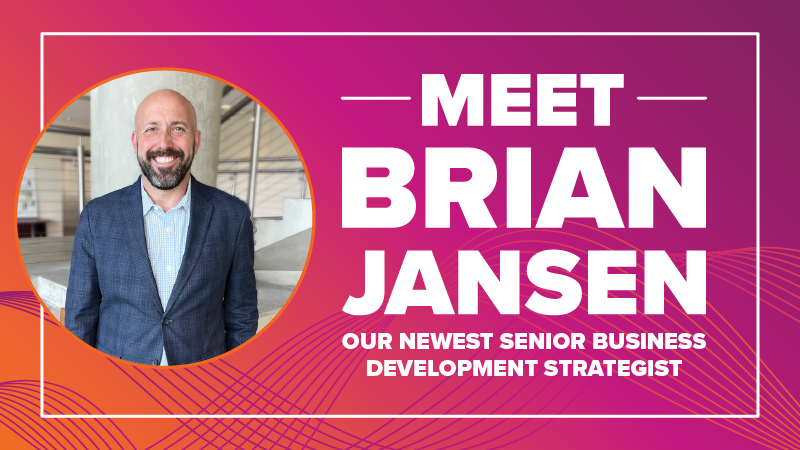Coming to Inboxes Near You: BIMI
Despite how it sounds, BIMI (pronounced: bih-mee), is not another type of cryptocurrency, another Gen Z acronym, or the name of a celebrity’s newborn.
It’s Brand Indicators for Message Identification (obviously!), or BIMI for short. It’s a way for brands to stand out in the email inbox with their logo, ultimately increasing visibility, engagement, and trust with their recipients. Recently, more and more Email Service Providers (ESPs), like Gmail, Yahoo Mail, AOL, etc., are starting to support BIMI. In fact, as of late October 2022, Apple Mail is supporting BIMI with the recent updates for iOS 16 and macOS Ventura.
At Spark451, we believe now is the time for colleges and universities to consider using BIMI to make an even stronger impression on students via their email marketing efforts. Read on for more details on how BIMI works and why it’s right for higher ed. We’ll even tell you how to set it up!
What is BIMI?
In layman’s terms (we’re not getting technical yet), BIMI allows brands to show their logos in the inbox next to their messages.
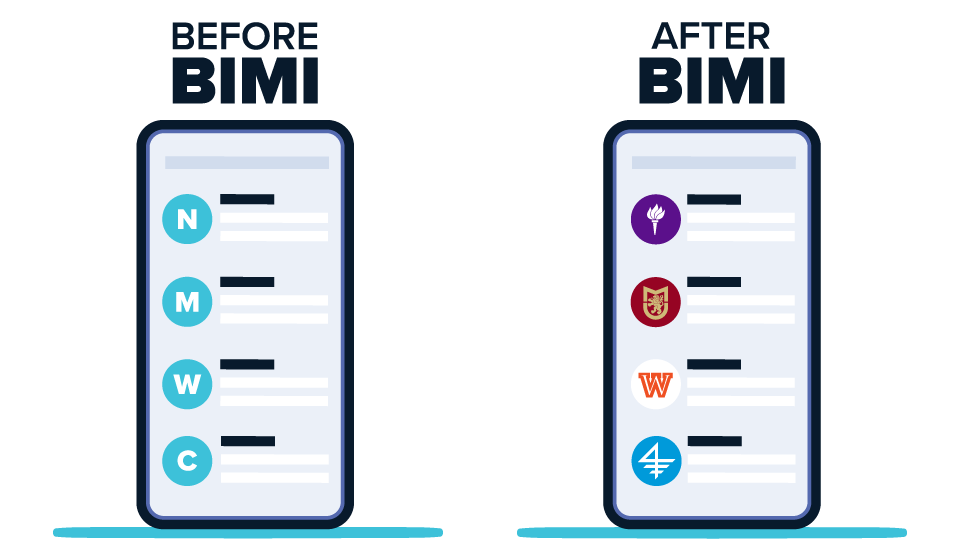
Interestingly, BIMI was not necessarily created with marketing in mind, but moreso to make the email industry more secure. In a world where email scams and phishing are more prevalent than ever, there are specific email sending authentications needed in order for BIMI to work. (More on those specifications later.)
Think about it: If someone knocks on your door claiming to be Ed Sheeran and offering you free concert tickets without showing his face, would you trust them and open the door? I would hope not — that sounds sketchy! But if he shows his face and it is actually THE Ed Sheeran, you would most likely open the door! Admittedly, opening college marketing emails isn’t as exciting as opening your door to Ed Sheeran, but you get the point. There’s more trust when you see a face, or logo.
Why is this a BIG DEAL for higher ed?
Initially, BIMI was only supported by a few ESPs, but now that Gmail announced their support of BIMI in July 2021, and now that Apple Mail is also on board, BIMI is officially a big deal for us as college marketers. Those ESPs represent a significant portion of our prospective student audience, at roughly 75–85%. Gen Z is a very visual bunch (looking at you, TikTok) and BIMI provides an opportunity to catch their attention in their already-flooded-with-college-marketing inboxes. Jumping on the BIMI train will be vital to the success of your email marketing campaigns.
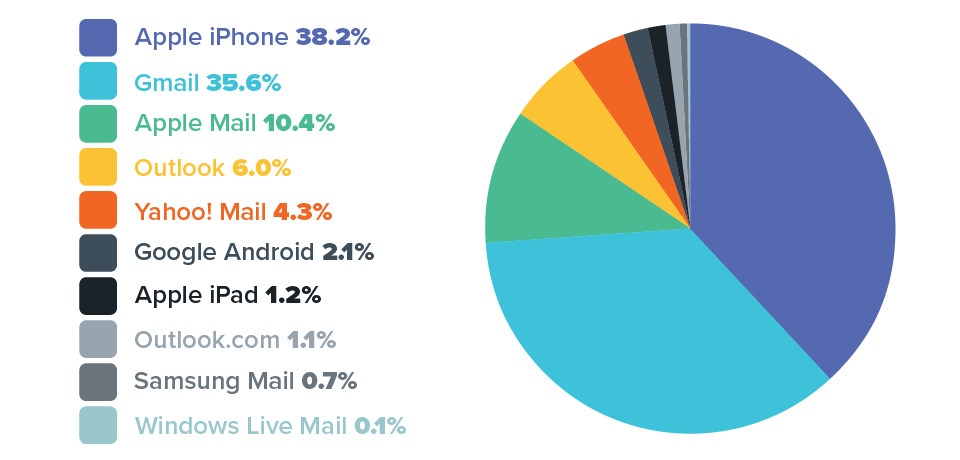
Other benefits to implementing BIMI?
I. Increased Open Rates
Based on the Yahoo Mail BIMI beta program, open rates increased by an average of 10% for emails using BIMI. Some studies even found that brand competitors that did not use BIMI showed a decrease in open rate, and that customer purchasing decisions were negatively impacted. This is your chance to stand out among competitor schools in the inbox — especially right now, while most schools don’t have BIMI.
II. Improved Email Deliverability (Inbox Placement)
Besides the obvious benefit of standing out in the inbox and attracting more opens, BIMI indirectly improves email deliverability, or inbox placement. By implementing BIMI, ESPs will see the increase in email engagement, proving that you’re sending legitimate and relevant messaging, AND that you’ve set the highest level of security to protect their users from phishing scams. Ultimately, the job of ESPs is to keep their users (our recipients) happy and safe. In turn, ESPs reward us by keeping our messages out of the spam folder and by giving us the privilege of showing our logos in the inbox: ✨BIMI✨
How is BIMI implemented?
A few requirements need to be met in order to implement BIMI into your email marketing. You’ll most likely require assistance from your IT/web team.
Step 1: Ensure email sending authentications are set up properly, specifically the DMARC policy
To send emails legitimately and not be classified as a spammer, there are specific sending authentications that must be aligned in your DNS records: Sender Policy Framework (SPF) and DomainKeys Identified Mail (DKIM). Something that makes BIMI a little more complicated to obtain is setting the proper Domain-based Message Authentication, Reporting, and Conformance (DMARC) record, or DMARC policy.
There are 3 types of DMARC policies: None, Quarantine, and Reject. Each can be thought of as a security level — with a policy of Reject being the highest — and ultimately protects your domain from being spoofed. Should a spammer impersonate your domain and send on your behalf, the DMARC policy would route their emails to spam (if the policy is set to Quarantine), or block their emails completely (if the policy is set to Reject). BIMI will only work if there is a secure DMARC policy in place, either Quarantine or Reject.
Step 2: Provide logo in a secure format with specific parameters
BIMI requires that a logo be in Scalable Vector Graphics (SVG) format to provide the highest quality image in the inbox for all devices. Overall, logos must be centered, have a solid background, a square aspect ratio, and be under 32 kilobytes. The logo must also be hosted on a publicly accessible server. This is how the BIMI record will “call in” and render the logo into the recipient’s inbox. Here is a detailed list of the BIMI logo specifications.
Step 3: Obtain a VMC
Step 4: Publish the BIMI record in your DNS
After you’ve jumped through the above hoops, the BIMI record can be added into the DNS. There are various tools that can help generate the BIMI record and confirm that it’s set up properly, like the BIMI LookUp & Generator. It can take anywhere from 24 hours to up to a few weeks for the logo to start appearing in the inbox.
Of course, BIMI is just the tip of the iceberg when it comes to delivering impactful email marketing campaigns for higher ed. Spark451’s email marketing experts and strategists can help you through everything from the technical aspects of implementing BIMI for your institution, to planning, crafting, and delivering robust, highly personalized campaigns that will support your enrollment goals. Feel free to reach out whenever you’re ready to talk.
Admissions and Enrollment Marketing Expert Brian Jansen Joins Spark451
Westbury, NY — Spark451, a Jenzabar company, is proud to welcome Brian Jansen, our newest Senior Business Development Strategist. Based in Portland, Oregon, Jansen will work closely with the company’s partner institutions primarily in the Midwest and Pacific Northwest to help them achieve their enrollment goals.
“Brian brings a great deal of valuable experience to this role,” says Steve Kerge, Vice President of Business Development, Spark451. “He’s spent significant time both in the trenches of various collegiate admissions offices and as a trusted strategic partner on the agency side. I’m very enthusiastic about the insights and support he will be able to deliver to our partner colleges and universities.”
Jansen holds a BA in psychology from St. Norbert College and an MS in marketing communication from Illinois Tech’s Stuart School of Business. For more than two decades, he has been moving the admissions needle for higher education institutions. Jansen started his career working his way up through the admissions and marketing ranks at a handful of campuses in the Chicagoland area, including Trinity International University, Illinois Tech, and The Chicago School of Professional Psychology. At different points of his journey, he gained experience serving a variety of audiences including traditional undergraduate students, non-traditional adult degree completion students, and graduate students. At one point, he even managed to boost enrollment for one institution by a whopping 20 percent in his first year!
In 2010, Jansen transitioned from on-campus roles into enrollment consulting. In the last 12 years, he has partnered with well over 75 institutions from around the country. Along the way, he has helped schools refine their recruitment and enrollment strategies, implemented multi-channel student search and application generation campaigns, and delivered data-driven funnel qualification via predictive modeling.
“I am thrilled to be able to continue helping higher ed institutions identify ways in which we can collaborate to achieve their specific goals and face challenges head on,” says Jansen. “To me, the relationships I’m able to build with partner institutions and their hardworking teams is the most rewarding, and it’s what I’m most excited about in this new role with Spark451.”
About Spark451
Spark451, a Jenzabar company, is a higher education enrollment strategy, technology, and marketing firm that combines creativity with powerful technology to achieve measurable results. With a mission to help colleges and students fuel their future, the firm integrates a multitude of communication channels and platforms for effective enrollment marketing, student search, creative services, and digital media. Since 2011, Spark451 has worked with over 200 colleges and universities nationwide. For more information, please visit spark451.com.
Looking Further Down the Funnel
Month: November 2022
By Erika Forrest-Martin and Ryan Hogan
Working in higher education right now can feel like walking in a blizzard. Everyone is doing their best to put one foot in front of the other without being able to see too far ahead. We’ve all been there. It’s very common to lose sight of anything beyond the next step — especially as the recruitment and application season picks up. However, this is also the exact reason it is important to plan ahead. Trust me, future-you will thank you.
In our recent College-Bound Student Survey for the Class of 2026, 65% of students indicated that they began to seriously look at college prior to the summer of their senior year. What is your plan to start engaging students before their senior year begins?
Let’s focus on an effective sophomore/junior search. Building early brand awareness is the foundation upon which you can begin to widen your funnel, putting your enrollment goals within reach. Being familiar with your institution is a prerequisite for students’ curiosity: When surveyed, almost 45% of the Class of 2026 said they would not open an email from a college if they had never heard of it. So, how can you make sure they’ve heard of you? Read on to see how we break it down step by step, focusing on the “who,” “how,” “when,” and “where” of an effective sophomore/junior search.
65%
of students indicated that they began to seriously look at college prior to the summer of their senior year
45%
of the Class of 2026 said they would not open an email from a college if they had never heard of it
Step 1: Figure out who you’d like to connect with.
What kind of students do you want to enroll? Where are they? What are their interests? Oftentimes, answering these questions is a daunting task in and of itself! Using tools like Spark451’s Purchase Modeling and Predictive Modeling can make this a breeze. By analyzing your institution’s historical data and comparing it with national enrollment trends, we can help you make a strategic name purchase, and then assign a score to those names ranking the likelihood of their enrollment.
Step 2: Determine how to talk to them.
27% of students from our College-Bound Student Survey indicated that they did not open an email from a college if it was too generic. While keeping brand messaging simple and clear is important, adding personalization is the name of the game. This is the Instagram/TikTok generation, where everyone has their own page, their own individualized timeline — and uniqueness is often celebrated. Getting creative with segmentation and personalized messaging is a great way to begin your relationship with these students.
Once you’ve managed to capture their attention, providing easy ways for them to indicate their interest is very important! Make sure you have a user-friendly lead form that is easily accessible in all of your communication channels.
Step 3: Plan for where you'll talk to them.
Multi-channel communication plans are going to be the most effective tools for building brand awareness. To start, introducing yourself through digital media is an excellent way to foster passive engagement. Having a social media presence on Instagram, TikTok, and Snapchat — or even better, running ads on these channels — is an excellent way to make your name more recognizable.
Of course, email will be the primary vehicle to discuss who your institution is and what it has to offer. 95% of students noted that they used email for their communication during their college search, with mailed materials (47%) and texting (43%) coming in as the next most popular channels. Reflective of this, students ranked email as their preferred communication method, with traditional mail coming in second and texting coming in third. (Also, 30% of respondents noted they were OK with receiving texts anytime!)
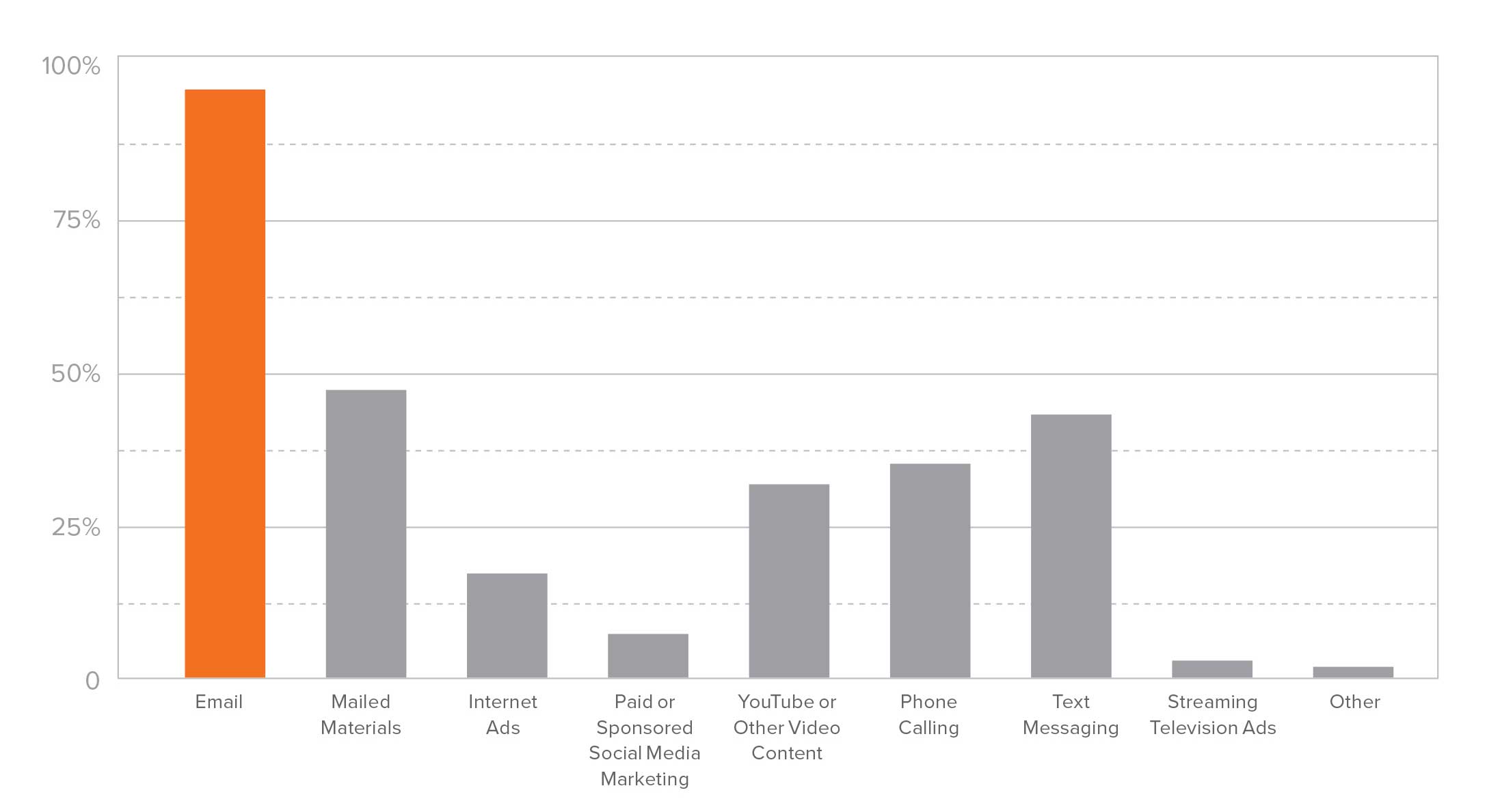
Once you’ve established your multi-channel communication plans, you can start passing the baton to your admissions counselors. Spring high school visits and college fairs are the best time to connect with sophomores and juniors in their natural habitat. In fact, according to our College-Bound Student Survey, almost 40% of students preferred to research a college with presentations/visits at their school. Pairing data insights from your communications with the student names you purchased (and potentially scored) can help you determine where to travel for the spring. Additionally, these trips provide the opportunity for counselors to make a personalized connection, as they can enter each visit with a list of students they know have already received and/or engaged with your communications. Making a good impression here, with the right students, is a recipe for success! (Did reading this just remind you that you need materials for the road? We can help with that, too!)
Another way to build relationships is to offer specific visit opportunities for sophomores and/or juniors on your campus. After all, 27% of the students we surveyed indicated that they knew their chosen school was right for them immediately upon visiting campus, so any way you can get students to your campus will likely result in a boost in enrollment later on. Something like a “Tips and Tricks for College Admissions” workshop could be a great way to garner interest from sophomores and their parents. For juniors, focusing more on your campus, scholarships, academic opportunities, etc., may be more appropriate.
Step 4: Engage the stakeholders.
We know parents/guardians are a huge factor in a student’s college search, with 88% of surveyed students indicating that their families had an impact on their college decisions. Engaging parents/guardians through their own specific campaign (separate from their students), is a very effective way to build brand recognition and establish relationships with these key influencers. Tailoring these messages to make them feel personalized is paramount, as the way you’d engage with a first-generation family may sound very different than how you might speak with a parent who is an alum, for example. At Spark451, we have the ability to append parent/guardian data to purchased names, making it easy to include them in your communication plans.
In a nutshell, running a successful sophomore/junior search comes down to playing a strategic long game in a thoughtful way. We know there are plenty of students who would be a great match for your institution — the challenge is finding them early enough in the process so that they are excited when it comes time to apply. Ensure you are talking to them as an individual so the student feels that any email, text, or postcard you’ve sent was meant for them — it can really make all the difference! If students and their families feel special, and that your school genuinely cares about them and their academic future, they’re going to be more likely to enroll.
To further discuss the details of your college or university’s sophomore-junior search, please reach out. We’ll be happy to help you refine your strategy and deliver a campaign that will support your goals. Trust us, future-you will thank you!
